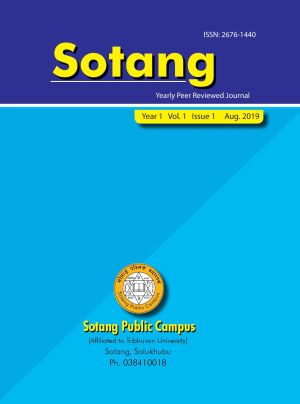बहुसांस्कृतिक सद्भाव र नेपाली भाषा शिक्षण {Multicultural harmony and Nepali language teaching}
DOI:
https://doi.org/10.3126/sotang.v1i1.45840Keywords:
सद्भाव, बहुसांस्कृतिक, शिक्षण, कार्यमूलकAbstract
भाषा र संस्कृति एकअर्काबाट प्रभावित छन् । संस्कृतिकै आधारमा भाषाको शब्दभण्डार, शैली, पदसङ्गति आदि निर्धारित हुन्छन् । सन्दर्भजनित अर्थ निष्पन्न गर्नाका लागि पनि संस्कृतिको भूमिका महŒवपूर्ण रहन्छ ।नेपाल बहुसांस्कृतिक, बहुधार्मिक र बहुभाषिक मुलुक भएकाले यसको प्रभाव भाषामा पनि देखिन्छ । योअध्ययनमा नेपालको सन्दर्भमा बहुसांस्कृतिक सद्भाव र नेपाली शिक्षणको महत्वको खोजीमा केन्द्रित छ । गुणात्मक ढाँचाको अवलम्बन गरी तयार पारिएको यस लेखमा द्वितीयक स्रोतबाट सामग्री सङ्कलन गरिएकोछ । तथ्याङ्कको उदाहरणीकरका लागि भने लेखकीय अनुभव प्रयोग भएको छ । संस्कृतिले रङ्गबोधक शब्द, नाताव्यवस्था बोधक शब्द, सम्बोधन शब्द, सामान्य र आदरार्थी शब्द तथा लिङ्गबोध शब्दमा प्रभाव पार्छ ।नेपाली भाषा शिक्षणका सन्दर्भमा भने पाठ्यक्रमको उद्देश्य चयन, पाठ्यवस्तु छनोट र उपयोग, सामग्री सङ्कलन, निर्माण र प्रस्तुतिमा, बहुविध संस्कृतिको प्रभाव स्वीकार, शिक्षण सिकाइ सहजीकरण, मूल्याङ्कनात्मक गतिविधि सञ्चालन, भाषिक सिपको शिक्षण, कार्यमूलक व्याकरण शिक्षण र उखान टुक्का शिक्षणमा सांस्कृतिक प्रभाव भेटिन्छ । यसर्थ भाषा शिक्षणका प्रत्येक गतिविधिमा संस्कृतिको प्रभाव पर्ने निष्कर्ष निकालिएको छ । यस अध्ययनले भाषा पाठ्यक्रम र पाठ्यपुस्तक निर्माणकर्ता लगायत शिक्षण सिकाइमा संलग्न सम्पूर्ण जिज्ञासु पाठकलाई संस्कृतिको भाषा शिक्षणमा उपयोगिता पहिचान गर्न सहयोग पुग्ने देखिन्छ ।
{Language and culture are influenced by each other. Language vocabulary, style, rank, etc. are determined on the basis of culture. The role of culture is also important in extracting contextual meaning. As Nepal is a multicultural, multi-religious and multi-lingual country, its influence can be seen in language as well. This study focuses on the search for multicultural harmony and the importance of Nepali teaching in the context of Nepal. This article is prepared using a qualitative format and collects material from secondary sources. Writing experience is used as an example of statistics. Culture influences words of color, words of kinship, words of address, common and respectful words and words of gender. , Cultural influence is found in conducting evaluative activities, teaching linguistic skills, teaching functional grammar and teaching proverbs. Therefore, it has been concluded that culture has an effect on every activity of language teaching. This study seems to help all curious readers involved in teaching and learning, including language curriculum and textbook creators, to recognize the usefulness of culture in language teaching.}




